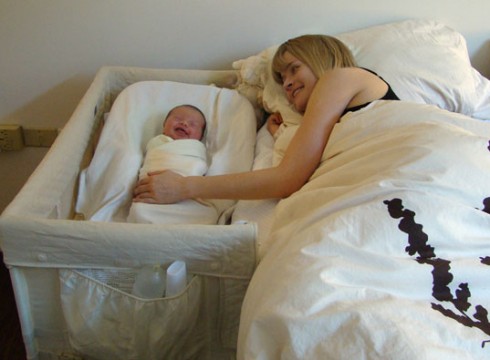
Courtesy of www.inhabitots.com
It turns out attachment parenting isn’t scandalous at all, though some still consider it to be. In my opinion, it’s the healthiest form of parenting for a child and it’s how I am raising my second son, Daniel. But, I have still received criticism from friends and even some family members for my choice.
Consider the history of attachment parenting…
During World War Two when Americans were stationed in Okinawa, they discovered a very curious phenomenon. At the time, the people of Okinawa had no known incidence of mental health problems. Depression and anxiety disorders were unknown. This was a very happy culture, indeed. Americans took a closer look at how children were being raised, and they observed that babies were worn by mothers, and slept in mother’s beds, and were always with siblings or older family members. No one was ever alone and affection was liberally given to all children of all ages.
This observation coincided with a study by the WHO. In 1950, the World Health Organization sponsored a study called “Maternal Care and Mental Health”. This is the study which promoted the now-famous Harry Harlow to experiment with Rhesus monkeys in finding out the effects of maternal separation on infants.
The experiment went as follows:
“In Harlow’s classic experiment, two groups of baby rhesus monkeys were removed from their mothers. In the first group, a terrycloth mother provided no food, while a wire mother did, in the form of an attached baby bottle containing milk. In the second group, a terrycloth mother provided food; the wire mother did not. It was found that the young monkeys clung to the terrycloth mother whether or not it provided them with food, and that the young monkeys chose the wire surrogate only when it provided food. Whenever a frightening stimulus was brought into the cage, the monkeys ran to the cloth mother for protection and comfort, no matter which mother provided them with food.” (1)
The study continued:
“When the monkeys were placed in an unfamiliar room with their cloth surrogate, they clung to it until they felt secure enough to explore. Once they began to explore, they occasionally returned to the cloth mother for comfort. Monkeys placed in an unfamiliar room without their cloth mothers acted very differently. They froze in fear and cried, crouched down, or sucked their thumbs. Some even ran from object to object, apparently searching for the cloth mother, as they cried and screamed. Monkeys placed in this situation with their wire mothers exhibited the same behavior as the monkeys with no mother.” (1)
One of the most important findings of this study was that it contradicted the traditional advice of child-reading at the time, which was to limit physical contact with the mother. It was believed that too much physical contact between infant and mother would result in spoiled and needy children who would never find independence as autonomous beings.
It was also thought at the time that feeding was the most important factor in mother-child bonding, not physical affection. And this was also a time when formula companies were pressing mothers to formula feed and not even consider breast-feeding their infants. Breast feeding was considered vulgar by upwardly mobile society and formula was considered as the logical advance in feeding and it was also considered to be more nutritious than mother’s milk.
[Article by Sarah Polyakov]
I love that co-sleeper. I was such a freak-show when my daughter was born that I practically had a mirror under her nose the entire time she slept. Paranoia doesn’t even begin to cover what I experienced. I slowly got over it but I sure lost a whole lot of sleep in the meantime.
We’re a co-sleeping family and I wouldn’t change a thing about it! I love it!
just love the co sleeper design,thanks for posting
thanks
ebay search
I think it’s very healthy method of parenting and I admire you for sitcking with it! Best of luck to you and your family.